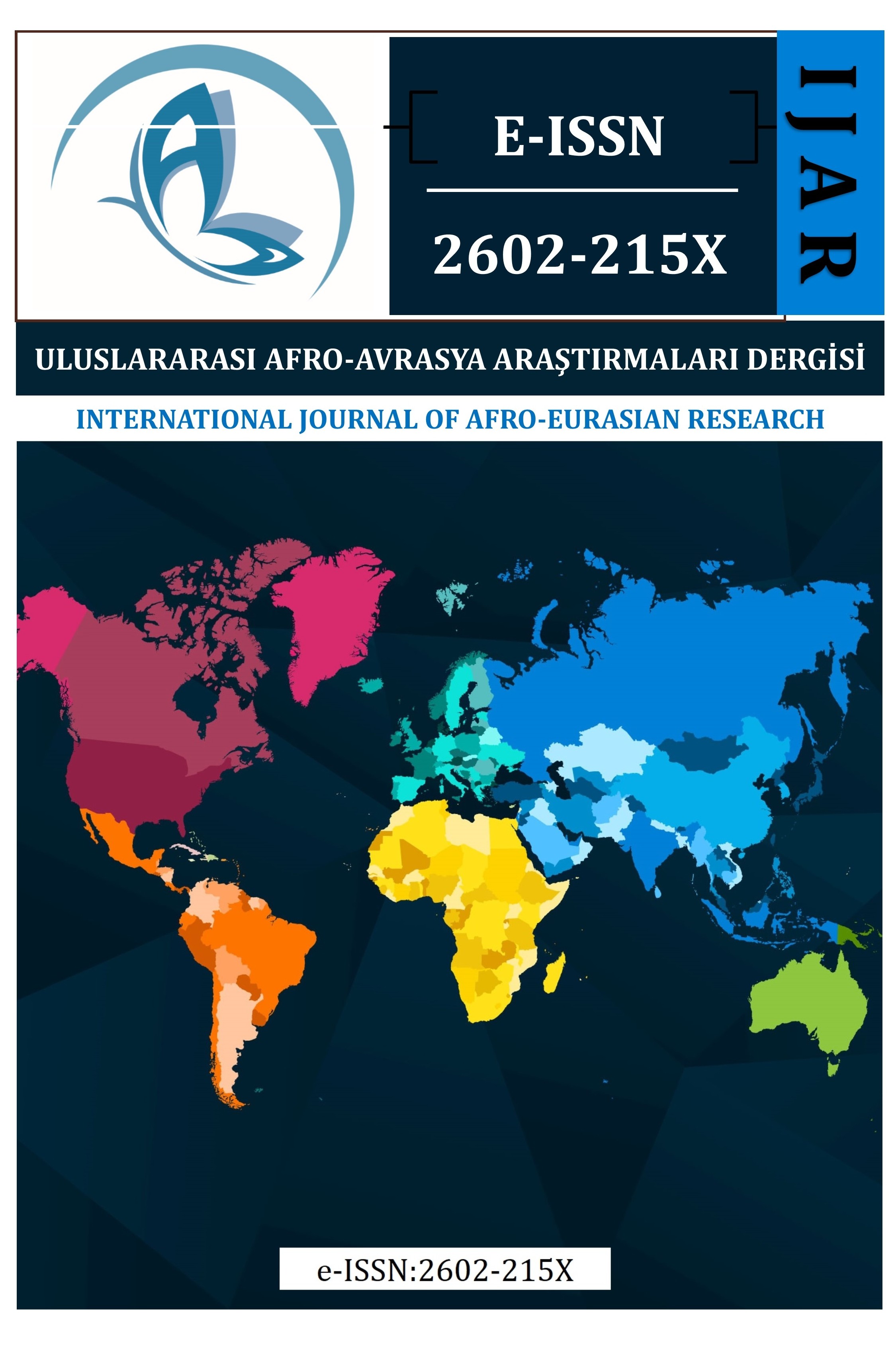TMS 2 STOKLAR STANDARDI AÇIKLAMA GEREKLİLİKLERİNİN 2016-2017 YILLARINA İLİŞKİN UYUM DÜZEYLERİNİN KARŞILAŞTIRILMALI OLARAK İNCELENMESİ: BORSA İSTANBUL’DA BİR UYGULAMA
Dipnot, Açıklama, Gereklilik, Uyum
COMPARATIVE INVESTIGATION OF THE COMPLIANCE LEVELS RELATION WITH THE DISCLOSURE REQUIREMENTS OF TAS 2 STOCK STANDARD IN 2016-2017 YEARS: AN APPLICATION IN BORSA ISTANBUL
Footenote, Disclosure, Requirement, Compliance,
___
- Akhtaruddin M. (2005). “Corporate Mandatory Disclosure Practices in Bangladesh”, The International Journal of Accounting, 40: 399-422.
- Ali, M. J.,Kamran A., ve Darren H. (2004). “Disc¬losure Compliance with National Accounting Standards by Listed Companies in South Asia”, Accounting and Business Research, 34 (3): 183-199.
- Alsaeed K. (2006).“The Association between Firm-specific Charac¬teristics and Disclosure: The case of Saudi Arabia”, Managerial Accounting Journal, 21(5): 476-495.
- Al-Shammari, B.(2011). “Factors Influencing the Extent of Mandatory Compliance with International Financial Reporting Standards: The Case of Kuwaiti Listed Companies”, Journal of International Business and Econo¬mics, 11 (4): 11-31.
- Al-Shammari, B., Brown P., ve Tarca A. (2008). “An Investiga¬tion of Compliance with International Accounting Standards by Listed Com¬panies in the Gulf Co-Operation Council Member States”, The International Journal of Accounting, 43: 425-447
- Büke T. (2014).”UFRS Dipnot Açıklama Gerekliliklerine Uyum: Literatür Araştırması”, Mali Çözüm Dergisi,124:179-190Cooke,T.E. (1989).”Voluntary Corporate Disclosure by Swedish Com¬panies”, Journal of International Financial Management and Accounting, 1(2): 171-195.
- Çetinoğlu S. (2018).Türkiye Muhasebe ve Finansal Raporlama Standartlarının Açıklama Gerekliliklerine İlişkin Uyum Düzeylerinin İncelenmesi: Borsa İstanbul’da Bir Uygulama, Yayınlanmamış Yüksek Lisans Tezi, Kütahya Dumlupınar Üniversitesi, Sosyal Bilimler Enstitüsü, Kütahya
- Çürük T., (2004). “Bağımsız Dıs Denetimin Muhasebe Seffaflığına Etkisi Üzerine Uygulamalı Bir Çalısma: Türkiye Örneği”, ODTÜ Gelisme Dergisi,31:149-165
- Demir V., Bahadır O. (2014). “An Investigation of compliance with International Financial Reporting Standards by listed companies in Tur¬key”. Accounting and Management Information System, 13 (1): 4-14.
- Dumontier, P., Raffournier B. (1998). “Why Firms Comply Voluntarily with IAS: An Empirical Analysis with Swiss Data”, Journal of International Financial Management and Accounting,9 (3): 216-245.
- Esen M.Ö. ve Sakin T. (2009).”Dipnot Açıklama Yükümlülüklerine Uyum: İMKB 100 Endeksinde Yer Alan Reel Sektör Firmalarının Durumu Üzerine Bir Araştırma”, İstanbul Üniversitesi İşletme Fakültesi İşletme İktisadı Enstitüsü Dergisi (Yönetim), 20 (64):112-124
- Glaum, Martin ve Donna L. Street (2003). “Compliance with the Disclosure Requirements of Germany’s New Market: IAS Versus US GAAP”, Journal of International Financial Management and Accounting,14 (1): 64-100.
- Holthausen, R. W. ve R. W. Leftwich (1983). “The Economic Consequences of Accounting Choice”, Journal of Accounting & Economics, 5: 77-117.
- Hossain, M. ve Hammami H. (2009). “Voluntary Disclosu¬re in the Annual Reports of an Emerging Country: The Case of Qatar”, Ad¬vances in Accounting, Incorporating Advances in International Accounting, 25: 255-265.
- Juhmani, O. I. H. (2012). “Factors Influencing the Extent of Corporate Compliance with IFRSs: Evidence from Companies Listed in Bahrain Stock Exchange”, Journal of International Business and Economics, 12 (2): 67-79.
- Malone, D.,Fries C. ve Jones T. (1993). “An Empirical Investigation of the Extent of Corporate Financial Disclosure in the Oil and Gas Industry”, Journal of Accounting, Auditing & Finance, 8 (3): 249-273.
- Naser K. (1998). “Comprehensiveness of Disclosure of non-financial Companies Listed on Amman Financial Market”, International Journal of Commerce & Management, 2,(8) : 88-119.
- Nobes, C., (1998). “Towards a General Model of the Reasons for the International Differences in Financial Reporting”, Abacus, 31(1-3):162-187
- Örten R., Kaval H. ve Karapınar A. (2012). Türkiye Muhasebe –Finansal Raporlama Standartları Uygulama ve Yorumları, Altıncı Baskı, Gazi Kitapevi, Ankara.
- Street, Donna L. ve Stephanie M. Bryant (2000).”Disclosure Level and Compliance with IASs: A Comparison of Companies with and without U.S. Listings and Filings”, The International Journal of Accounting, 35 (3): 305-329
- Tadesse, Solomon, (2006). “The Economic Value of Regulated Disclosure: Evidence From The Banking Sector”, Journal of Accounting and Public Policy,25:32-70
- http://www.denetimnet.net/UserFiles/Documents/UFRS/UMS%202.pdf (15.01.2019)
- http://www.kgk.gov.tr/Portalv2Uploads/files/Duyurular/v2/TMS/TMS%202%20Stoklar.pdf (16.01.2019)
- Başlangıç: 2016
- Yayıncı: Hakan ARIDEMİR
NURETTİN TOPÇU’NUN GENÇLİĞİN İÇİNE SÜRÜKLENDİĞİ YOZLAŞMA SÜRECİNİN SEBEPLERİNE İLİŞKİN GÖRÜŞLERİ
SİGORTA SEKTÖRÜNÜN HAYAT DIŞI BRANŞININ FİNANSAL VE TEKNİK PERFORMANSLARININ ANALİZİ
İnci Merve ALTAN, Murat YILDIRIM
“FOLKLOR VE İSLAM” PROBLEMİNE ARKAİK-MİTOLOJİ DÜŞÜNCE KONTEKSİNDE BAKIŞ
DÖNÜŞEN DÜNYA DÜZENİNDE “BRICS” ve TÜRKİYE’YE ETKİSİ
Deniz İSTİKBAL, Şerif DİLEK, Merve YANARTAŞ
GELİŞMEKTE OLAN ÜLKELERDE AÇIK YÖNETİM BAĞLAMINDA AÇIK BÜTÇE SÜRECİ
BATI AFRİKA’DA KENTLEŞME HAREKETLERİ: LAGOS ÖRNEĞİ
GÜNEY AFRİKA'YI ULUSLARARASI HİYERARŞİDE KONUMLANDIRMAK: YENİ YÜKSELEN ORTA ÖLÇEKLİ GÜÇ
TRAVMA SONRASI BÜYÜME VE GELİŞİM
TÜRKİYE'DE YAŞAYAN GEÇİCİ KORUMA ALTINDAKİ SURİYELİLERİN VERGİ ADALETİ ÜZERİNDEKİ ETKİLERİ
TEDARİK ZİNCİRİ YÖNETİMİNİ CARREFOUR NASIL GERİ DÖNÜŞTÜRDÜ:BİRLEŞİK ARAP EMİRLİKLERİNDEN BİR VAKA
